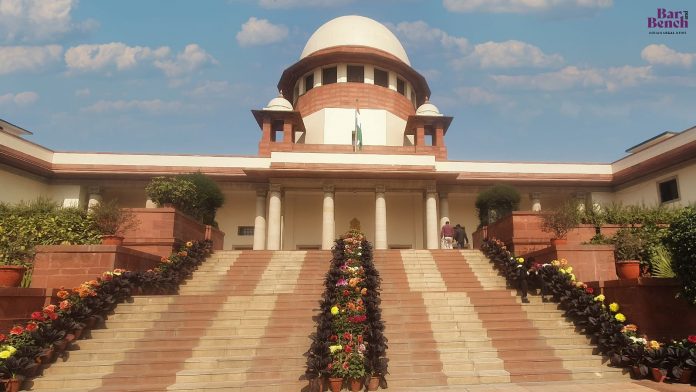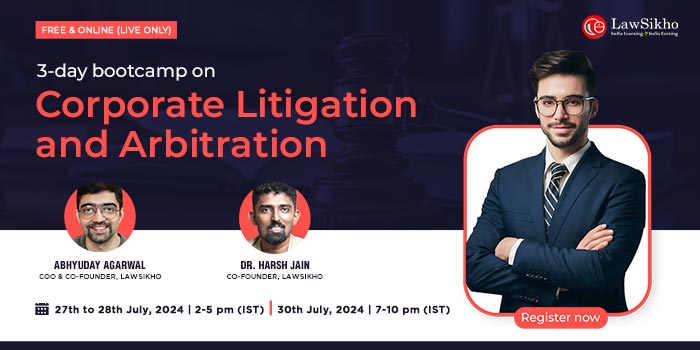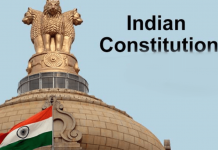This article is written by Gautam Badlani. This article analyses the types of jurisdiction that are conferred on the Supreme Court. The Supreme Court has six types of jurisdiction: original, appellate, advisory, review, inherent, and extraordinary jurisdiction. The article comprehensively explains the concept of special leave petitions and public interest litigation and also sheds light on the development of the epistolary jurisdiction of the Supreme Court.
Table of Contents
Introduction
The Supreme Court of India is the court of final appeal and the highest constitutional court. In order to enable it to perform its sacred duties, it has been conferred with a very wide jurisdiction. The Court hears appeals from the orders of the subordinate courts, interprets and upholds the Constitution, safeguards and shields the fundamental rights of the citizens, and resolves inter-state disputes.
At the time of its inception in 1950, the Supreme Court inherited the jurisdiction of the Federal Court. Since then, the practices and procedures of the Supreme Court have undergone significant change. The Supreme Court of India is often called the most powerful national court in any country.
In its 58th Report, the Law Commission of India highlighted the multi-jurisdictional role of the Indian Supreme Court. The Law Commission states that the Indian Supreme Court is a federal court as it has exclusive jurisdiction to decide disputes between and among the Union and the states. It is the highest constitutional court as it is the protector of fundamental rights and the final court of appeal in cases involving substantial questions of law and interpretation of the provisions of the Constitution. It is also the national court, as appeals from the judgments of the high courts can be made before the Supreme Court even where the matter involves ordinary questions of law.
Historical overview of jurisdiction of the Supreme Court
The history of the Supreme Court can be traced back to the Government of India Act, 1935. The Act established the Federal Court, which was responsible for adjudicating the disputes between the federal states and provinces. Furthermore, the Federal Court was also empowered to hear appeals from the High Courts. An appeal from the judgement of the High Court could be made before the Federal Court if the High Court certified that the matter involved substantial questions of law.
However, the Federal Court could make only declaratory judgments. The Court had the power to declare the law but could not seek enforcement of its decision.
The jurisdiction and powers of the Supreme Court are similar to those of the Federal Court. However, in some matters, the jurisdiction of the Supreme Court has expanded beyond that of the Federal Court. For instance, there was no provision in the Government of India Act that empowered the Federal Court to entertain a special leave petition. Thus, in the absence of a certificate by the High Court to the effect that the matter involved substantial legal questions, no appeal could be preferred before the Federal Court.
Article 124 of the Indian Constitution provides for the establishment of the Supreme Court. The Supreme Court became operational on 28th January, 1950, and the first judge to preside over the Supreme Court of India (before independence) was Hon’ble Mr. Justice Harilal Jekisundas Kania.
Original jurisdiction of the Supreme Court
Original jurisdiction is the power of the court to hear and adjudicate upon the matter as the court of first instance.
Article 131 elucidates the original jurisdiction of the Apex Court. It provides that the Court will be competent to exercise original jurisdiction:
- In disputes between the Union Government and one or more states
- In such disputes, where the Union Government and one or more states constitute one party and one or more states constitute the other party,
- In disputes between two or more states
The disputes under this Article must raise a pertinent question of legal rights. No other court has the power to try the disputes envisaged under this Article. The intent of the Constitution makers behind conferring such wide jurisdiction on the Apex Court was to ensure that disputes of such nature were decided once and for all at the highest federal court.
However, the proviso to Article 131 states that the jurisdiction of the Supreme Court can be excluded by virtue of any treaty, agreement, or similar instrument. This Article is based on Section 204 of the Government of India Act, 1935.
Moreover, the wording of Article 131 implies that it has to be read in accordance with and “subject” to other constitutional provisions. Thus, the original jurisdiction under Article 131 can be restricted by other constitutional provisions, such as in the case of disputes relating to the operation and distribution of inter-state river waters (Article 262) or presidential recommendations to the Finance Commission under Article 280.
Apart from these constitutional provisions, Section 25 of the Code of Civil Procedure, 1908, provides that the Supreme Court can transfer any matter from the High Court or civil court of one state to the High Court or civil court of another state.
In the landmark case of State of Bihar v. Union of India (1969), the plaintiff was the State of Bihar, and the defendants were the Union Government (1st defendant) along with Hindustan Steel Limited and Indian Iron and Steel Company Ltd. The plaintiff brought an action before the Court under Article 131, and the primary issue that came before the Court was whether the cause of action could be brought under the aforementioned Article.
The Court held that Article 131 requires the Court to adjudicate only on the legal right concerned, and the Court is not required to adjudicate on the complete dispute. The Court further held that the petition under Article 131 was not maintainable, as the dispute would fall within the ambit of Article 131 only if no private party was involved in the dispute. Even if the private party was impleaded jointly with the government, the petition would be beyond the scope of Article 131.
Restrictions on original jurisdiction
The original jurisdiction of the Supreme Court, under Article 131, cannot be invoked to challenge the constitutional validity of any law passed by the legislature. This limitation was recognized by the Supreme Court itself in the case of State of Madhya Pradesh v. Union of India (2011). In this case, the State of Madhya Pradesh had filed a suit against the Union of India and the state of Chattisgarh. The petitioner was seeking the production of records for certain notifications and orders. Subsequently, Madhya Pradesh filed an amendment application seeking to add another prayer for the declaration of certain provisions of the Madhya Pradesh Reorganisation Act, 2000, as unconstitutional. However, the Supreme Court, while declining the application, observed that the original jurisdiction of the Supreme Court cannot be invoked to challenge the constitutional validity of a central law.
The constitutional validity of any law can be challenged under Article 32, and the Court may exercise its writ jurisdiction to grant the appropriate review. However, it is pertinent to note that in the State of Jharkhand v. State of Bihar (2015), the Court expressed doubts over the correctness of the rationale laid down in the Madhya Pradesh case. The Court observed that, as per Article 131, the jurisdiction of the apex court extends to ‘all disputes’ between the Centre and the states. The dispute may relate to a question of fact or a question of law. Thus, the jurisdiction of the Court cannot be limited by excluding disputes relating to the validity of a central law. The Court thus referred to the decision of the State of Madhya Pradesh v. Union of India to a larger bench for determining its correctness.
Writ jurisdiction of the Supreme Court
Furthermore, the Court enjoys original jurisdiction in matters relating to the enforcement of the fundamental rights of individuals. Any individual can approach the Supreme Court in cases of violation of fundamental rights, and the court can issue writs for granting the appropriate remedy. India adopted the concept of writs from the British legal system, which empowers the courts to issue prerogative writs.
It is pertinent to note that Article 32 provides a guaranteed remedy for the enforcement of fundamental rights. As this Article is included in Part III, the right to invoke the jurisdiction of the Supreme Court for the enforcement of fundamental rights is in itself a fundamental right.
Where a common matter is pending before two or more high courts or before the Apex Court and one or more high courts, the Supreme Court, upon being satisfied that the concerned matter is of public importance, can withdraw the matter from the High Court and proceed to dispose of the matter itself.
Article 139A provides that when a matter involving a substantial question of law is pending before the Apex Court and also before any High Court, or where such a matter is pending before two or more High Courts, the Court can withdraw the matter from the High Court and decide the matter by itself.
It is pertinent to note that the original jurisdiction of the Court, with respect to the enforcement of fundamental rights, is appellate and concurrent in nature and not exhaustive. This is essential, as otherwise the citizens would have no remedy but to approach the Supreme Court in the event of a violation of any fundamental rights.
Under Article 138, Parliament can confer original jurisdiction on the Supreme Court through the medium of legislation. For example, the Apex Court is empowered to commence international commercial arbitration by virtue of the Arbitration and Conciliation Act, 1996.
Article 32 provides that the Court can issue the following for the enforcement of fundamental rights:
Habeas Corpus
Writ ordering the production of the detainee before the Court in order to ascertain whether the detention is legal or unlawful. By virtue of the effect of the 44th Constitutional Amendment, which provides that Article 21 cannot be suspended even at the time of a declaration of emergency, the writ of Habeas Corpus can be effectively issued at the time of an emergency as well.
The writ of habeas corpus cannot be used to seek the release of a person who has been imprisoned by a court of law upon being found guilty of a criminal charge. Moreover, the writ of habeas corpus cannot be used as an instrument to interfere with the contempt proceedings initiated by the Parliament or by a court of law.
In AK Gopalan v. State of Madras (1950), Gopalan had been detained under the Preventive Detention Act, 1950. The detention was not based on any trial. A writ of habeas corpus was filed on the ground that the detention was a violation of Article 21 of the Constitution. However, the Court denied the petition on the ground that Article 21 states that a person can be deprived of his personal liberty if the ‘procedure established by law’ is followed. In this case, Gopalan had been detained under the Preventive Detention Act, 1950, which was a law made by Parliament. Thus, the Court held that the detention was valid as it complied with the procedure laid down under the Preventive Detention Act.
In the landmark case of Sunil Batra v. Delhi Administration (1979), Sunil Batra, who was a prisoner in Tihar Jail, wrote to the Supreme Court about the cruel treatment meted out to the inmates. The Supreme Court treated the letter as a writ petition and held that even prisoners were entitled to seek the constitutional protection guaranteed under Article 21 through the medium of writ.
In Rudal Sah v. State of Bihar (1983), Rudal Sah had been charged and imprisoned for the offence of murdering his wife. However, he was subsequently acquitted. Even after his acquittal, the authorities did not release him, and he continued to remain in prison for 14 years after his acquittal. A writ of habeas corpus was filed for his release. The Court ordered that the prolonged imprisonment of Rudal Sah was a violation of his fundamental rights, and the state was directed to pay compensation to him.
Quo warranto
This writ is issued by a court to a public officer, requiring him to explain the authority behind his actions. The public officer is required to prove the authority with which he is holding the office and exercising the powers of the public office. This writ is ordinarily issued against executive officers holding public offices. It is pertinent to note that a writ of quo warranto cannot be issued against a private office.
In University of Madras v. Govinda Rao (1965), the respondent filed a writ petition for the issue of quo warranto, calling upon Anaiah Gowda (appellant no. 2) to show the authority under which he held the post of Research Reader at the University of Madras. The university had prescribed that a research reader should have a first or second class master’s degree from an Indian university or an equivalent degree from any foreign university. The High Court issued the writ and ordered the removal of the appellant from the office on the ground that he did not have the legal authority to hold the office as he did not have a first or second class Master’s degree from any Indian university.
However, the Supreme Court set aside the decision of the High Court and observed that the appointment did not contravene any statute or ordinance and was made in accordance with the recommendation of the Board of Experts. The appellant did hold a Master’s degree from a foreign university and thus satisfied the criterion for appointment. The Supreme Court pointed out that the courts should be reluctant to interfere with the appointments made by the experts. The Court pointed out that the purpose of the writ of quo warranto is to ensure that no person is able to illegally hold a public office in connivance with the executive or due to the apathy of the executive. The courts can issue the writ of quo warranto only if the following two conditions are satisfied:
- The concerned office is a public office
- The public office is illegally held by a usurper
Mandamus
The Court issues a writ of Mandamus to direct a public official to resume the discharge of his public duty. It is pertinent to note that this writ cannot be issued against a private person, a high court chief justice, the President of India, or the Governor of any state.
In Bombay Municipality v. Advance Builders (1971), a town planning scheme had been prepared by the Bombay Municipality and approved by the State Government. However, the municipality did not take any steps for the implementation of the scheme. The Supreme Court observed that, as per the provisions of the Bombay Town Planning Act, 1954, the municipality was under a statutory duty to implement the town planning scheme. Since the municipality had not been performing its statutory duties, the Supreme Court issued a writ of mandamus directing the municipality to implement the scheme.
Prohibition
The Court issues this writ to prevent a subordinate court from exceeding or usurping its jurisdiction or from acting in contravention of the law. This writ is issued at the time when a subordinate court decides to try a matter in excess of its jurisdiction.
In S. Govinda Menon v. the Union of India (1967), the appellant, who was a member of All India Services, was suspended by the state government after some allegations of misconduct had been raised against him. An inquiry officer was appointed and a show cause notice was issued to the appellant. The appellant filed a writ petition pleading for the issue of a writ of prohibition to restrain the government from proceeding against him. The appellant contended that he had been holding the post of Commissioner of Hindu Religious and Charitable Endowments and since the office of the Commissioner was a corporation sole, no disciplinary proceedings could be initiated against him. However, the Court pointed out that the writ of prohibition can be issued only in three situations. It can be issued where the court or inferior tribunal:
- Acts without jurisdiction
- Oversteps its jurisdiction
- Acts contrary to the principles of natural justice
In the present case, the allegations against the appellant reflected on his integrity as a member of the All India Service, and thus the government was competent to initiate the disciplinary proceedings. Thus, the plea for the issue of a writ of prohibition was declined.
Certiorari
Where the Subordinate Court decides a matter that is beyond its jurisdiction or where the matter is decided in contravention of the natural justice principles, the Court is empowered to issue a writ of certiorari, thereby setting aside or quashing the erroneous decision.
In Central Council for Research in Ayurvedic Sciences v. Bikartan (2023), the Supreme Court pointed out that a writ of certiorari can be issued when the error of law is apparent on the face of the record. The Court further clarified that the writ of certiorari cannot be issued merely in the case of a technical or formal error. The error must be manifest or patent on the face of the record.
Advisory jurisdiction of the Supreme Court
Article 143 confers advisory jurisdiction upon the Apex Court. The advisory opinion of the Supreme Court can be requested by the President on any question of law or fact that is of public importance and where the President considers obtaining such an opinion to be expedient.
Similar to the original jurisdiction, the advisory jurisdiction also stems from the Government of India Act, 1935. Section 213(1) of the Government of India Act, 1935, provided for the advisory jurisdiction of the Federal Court. The essence of this section was incorporated into Article 143 of the Constitution.
It is pertinent to note that the jurisdiction of the Court under Article 143 is merely advisory in nature and is not binding on the President or the Government. The Court does not pass any orders or decrees but merely gives its opinion, on the matter concerned, to the President.
So far, the President has referred 13 matters to the Supreme Court under Article 143.
Landmark case laws

- In the landmark case of Re: Keshav Singh, Legislative Assembly, Keshav Singh, along with his colleagues, had printed a pamphlet alleging that one of the MLAs was involved in corruption. Consequently, he was summoned by the Legislative Assembly. While his colleagues appeared before the Assembly, Keshav did not follow the summons on grounds of financial constraints. The Assembly ordered his arrest. A petition was filed before the Allahabad High Court pleading that Keshav’s arrest was unconstitutional.
Subsequently, two judges of the High Court passed an order in favour of Keshav. The State Assembly passed a resolution ordering that the two judges be taken into the custody of the Assembly. The matter went before the Allahabad High Court and was heard by a 28-Judge Bench. The High Court passed an interim order, staying the resolution of the Assembly.
Since the matter involved a dispute between the High Court and the State Assembly, the President sought the advisory opinion of the Supreme Court under Article 143. The Apex Court held that the Allahabad High Court was competent to hear the Habeas Corpus petition filed on behalf of Keshav as well as to pass the interim order against the Assembly resolution, and that the Assembly had no authority to order the detention of the judges.
It is pertinent to note that the Apex Court observed that the advisory opinion of the Court is not binding and that it is at the discretion of the President whether to abide by the opinion or not. However, the opinion carries immense judicial weight.
- In the case of M. Ismail Faruqui v. Union of India, the President sought the advisory opinion of the Court on the issue of whether there was a temple at the sight of Babri Masjid. However, the Court held that the President must provide appropriate reasons for seeking the Court’s opinion. The Court further held that it was not bound to provide the advisory opinion where it considered the reasons to be improper. The Court thus refused to give its advisory opinion on the ground that the reference was superfluous.
- In Re: Kerala Education Bill v. Unknown (1958), the Kerala Education Bill, 1957, was passed by the Kerala State Legislature, and the President had sought the opinion of the Apex Court on the constitutionality of some of its provisions. The governor had not given his assent to the Bill and had sought the president’s consideration. The issue that came before the Court was whether an advisory opinion could be sought in relation to the provisions of the Bill, which has not yet been incorporated as a statute. The Court made several observations regarding the scope and objectives of Article 143:
- The Court observed that Article 143(1) provides that the Court “may” give its opinion to the President on the matter referred to, and hence the advisory opinion is a discretionary jurisdiction of the Court, and the Court is not bound to give the opinion to the President.
- However, merely because a Bill has not become applicable as a law, there could be no grounds for the Court to decline to exercise its jurisdiction.
- The Court further noted that the purpose of Article 143 is to enable the President to clear his doubts regarding a question of law by referring the matter to the Supreme Court.
- The Court held that it would consider only the question that was referred to by the President and that it could not go beyond the scope of the question.
- The Court further drew a distinction between the reference made under Article 143(1) and Article 143(2). Article 143(2) provides that where such a matter as provided in the proviso to Article 131 is referred to the Court by the President, the Court “shall” provide its opinion to the President. The proviso to Article 131 excludes the original jurisdiction of the Court in relation to disputes arising out of agreements, treaties, or other such instruments that were entered into before the Constitution came into effect. The Court held that while Article 143(1) makes it discretionary for the Court to give its opinion, Article 143(2) makes it mandatory for the Court to give its opinion in matters referred to by the President.
Appellate jurisdiction of the Supreme Court
Article 132 provides for the appellate jurisdiction of the Supreme Court. The Supreme Court can entertain an appeal against a High Court’s “judgement, decree, or final order” provided that the High Court certifies that the matter involves a “substantial question of law.“
Civil Appeals
Article 133 provides that an appeal can be made before the Supreme Court of India from any judgement, decree, or final order of the High Court if the High Court is satisfied that the matter involves a substantial question of law and the High Court is satisfied that such a question of general importance needs to be determined by the Apex Court. Earlier, only civil matters that involved a dispute of Rs. 20,000 or more could be appealed before the Supreme Court. However, by the Constitution (Thirtieth) Amendment Act, 1972, the financial limit of Rs. 20,000 was removed.
The expression “final order” means an order that would not give rise to any further action. In the case of Ramachand Manjimal v. Goverdhandas Vishindas Ratanchand, a stay order was granted by the judicial commissioner, and it was further certified by him that the order was a final order. However, the Privy Council held that the order did not finally determine the rights of the parties and was yet to be determined. Hence, the order could not be said to be a final order.
Criminal Appeals
Article 134 provides that an appeal from any judgement, sentence, or final order of a High Court in any criminal proceeding can be made before the Supreme Court of India if the High Court certifies that the matter is fit to be appealed before the Supreme Court.
In criminal matters, an appeal can be preferred before the Supreme Court, where the High Court endorses, through a certificate, that the matter be appealed before the Supreme Court. It is pertinent to note that where a review is preferred on the basis of the High Court’s certificate, it is at the discretion of the Supreme Court whether to allow the review petition or not. If the Supreme Court does not accept the certificate of the High Court, then it may permit the appellant to file a special leave petition under Article 136.
In the case of Mohinder Singh v. the State (1950), an appeal was preferred before the Apex Court from the judgement of the High Court of Punjab and Haryana. The High Court upheld the death sentence of the appellant. The Apex Court held that the High Court is to give its certificate only in exceptional cases. Further, the Court permitted the appeal on the ground that it was one of the special cases in which a criminal appeal can be preferred, as the accused had been convicted even though the evidence was insufficient. The Court set aside the conviction of the appellant.
Article 134(2) provides that the Parliament may, by law, expand the criminal appellate jurisdiction of the Supreme Court. In exercise of this power, the Parliament enacted the Supreme Court (Enlargement of Criminal Appellate Jurisdiction) Act, 1970. By this Act, the Supreme Court was empowered to entertain criminal appeals even without the certificate of the High Court if certain conditions were fulfilled. An appeal can be made before the Apex Court without the endorsement of the High Court if either or both of the following conditions are satisfied:
- Where a person is sentenced to death by a High Court while reversing the order of acquittal.
- Where the High Court withdraws the matter from a subordinate court and conducts the trial and subsequently sentences the accused to death.
In Pritam Singh v. State (1950), it was held that where an appeal is preferred upon the fulfilment of any or both of the aforementioned conditions, then review is claimed as a right.
Matters relating to the Constitution
Constitutional matters do not fall under civil or criminal matters. Appeals from the decisions of the High Court in constitutional matters can be made before the Supreme Court if the High Court certifies that the case involves a substantial legal question that relates to the interpretation of the Constitution. In many cases, the Supreme Court also entertains special leave petitions where appeals relate to constitutional matters.
It is pertinent to note that where an order is passed by a single judge bench of a high court, it is at the discretion of the aggrieved party to decide whether to file an appeal before the Supreme Court or file a revision application before a larger bench of the same high court. In R.D. Agarwal v. Union of India (1971), a judgement was made by a learned single judge of the Delhi High Court, and the learned judge suo motu granted the certificate of appeal under Article 132. However, the aggrieved party did not wish to file an appeal before the Supreme Court. The party filed an application to refer the matter to a bench of the same high court. The Supreme Court held that granting a certificate under Article 132 suo motu was improper, and the choice of the party to seek reference to the matter before a bench of the same High Court cannot be restricted by the grant of a certificate under Article 132.
Review jurisdiction of the Supreme Court
The Supreme Court enjoys review jurisdiction under Article 137 of the Constitution. This Article provides that the Supreme Court has the power to review its own judgments and orders. The review jurisdiction is also envisaged under Part VIII, Order XL, of the Supreme Court Rules, 1966.
A review application can be made before the Supreme Court within 30 days of the concerned judgement. Furthermore, the application must have the certification of an advocate on record.
It is pertinent to note that the review jurisdiction is based on the discretion of the court, and the court may refuse to review its earlier judgement. The Court usually exercises this jurisdiction when an error is discovered subsequent to the judgement and such error is believed to have caused a miscarriage of justice. Furthermore, if any material evidence is discovered subsequent to the judgement and such evidence could not be found earlier despite the best efforts of the party, then the Court may review its judgement. However, the Court will not exercise its review jurisdiction merely for trivial errors.
In the case of Union of India v. Sandur Manganese & Iron Ore Ltd., the review application was filed before the Court on the ground that the Court had incorrectly quoted the Expert Committee Report on which it had relied in the judgement. The Court, however, held that even if the wrongly quoted portion was deleted, the judgement would be the same and, hence, the clerical error could not be a ground for review. Further, the Court held that merely because an alternate view is possible to the dispute could not be a sufficient ground for invoking the review jurisdiction. Only when there is a grave error or omission in the judgement, the Court will permit a review.
Article 137 also provides that the review jurisdiction of the Court is subject to the laws enacted by Parliament under Article 145. Thus, the review jurisdiction of the Court is subject to Order XLVII Rule 1 of the Code of Civil Procedure, 1908. It provides for three grounds on which the review can be conducted. The grounds are
- Discovery of new evidence: The aggrieved party may appeal for review upon the discovery of new, important evidence. However, it is pertinent to note that the party applying for review has to show that such new evidence could not have been discovered earlier, despite the exercise of due diligence by the party. If it is shown that the evidence was undiscovered at an earlier stage due to the negligence of the party, then the application would fail.
- Apparent error: Where there is an “error apparent on the face of the record,” then review can be permitted by the Court. The error must be a material one and should have adversely affected the appealing party. The error should be patently apparent without the need for any arguments.
In G.L. Gupta v. D.N. Mehta (1971), the Supreme Court permitted a review petition because Section 23C(2) of the Foreign Exchange Regulation Act, 1947, was not brought to the notice of the Court at the time of the proceedings. The Court consequently set aside the imprisonment sentences of the petitioners.
- Any sufficient reason: Where the Court feels that there is sufficient reason for permitting the review, it may allow the review application of the aggrieved party.
Inherent jurisdiction of the Supreme Court
The Supreme Court of India also enjoys inherent jurisdiction. Article 71 of the Constitution provides that all disputes relating to the election of the President or the Vice President shall be decided by the Supreme Court of India.
Furthermore, the Court has the power to punish for contempt under Article 129. The Court can take up a contest matter either by itself, i.e., suo moto, or on the recommendation of the Attorney or Solicitor General. Furthermore, any person can file a contempt petition before the court.
In the case of Delhi Judicial Service Association v. State of Gujarat (1991), the Apex Court held that it has the power to punish not only its own contempt but also the contempt of the courts subordinate to it. The Court further held that the power to grant appeals from the order of any court or tribunal within the country confers the Court with “supervisory jurisdiction over all courts in India.”
Extraordinary jurisdiction of the Supreme Court
Special Leave Petition
Under Article 136, the Court has the power to hear an appeal against the judgement, decree, or order of any court or tribunal situated within the territorial limits of India. The power of the Supreme Court under Article 136 corresponds with the power that the Judicial Committee of the Privy Council had in relation to permitting appeals in exercising its Royal Prerogative. The Constitution does not specify any particular conditions under which a special leave petition can be entertained by the Supreme Court. Thus, the Court may, at its discretion, permit any party to file an appeal under Article 136.
The Supreme Court exercises its extraordinary jurisdiction in exceptional cases where irregularity of procedure or violation of the principles of natural justice results in grave miscarriage of justice. It is pertinent to note that the power to entertain a special leave petition is a discretionary power of the Supreme Court, and no person can assert it as a right. Moreover, the special leave petition can be filed against final as well as interlocutory orders or any court or tribunal.
The Supreme Court enjoys wide discretionary power under Article 136. In the landmark case of Pritam Singh v. State (1950), the Supreme Court observed that Article 136 confers wide discretionary power on the Court. However, such power should be used sparingly and only in exceptional cases. The court must grant a special leave petition only when it is shown that grave and substantial injustice has been done to the party. The Court enjoys residue power under Article 136; that is, if a matter cannot be brought before the Supreme Court under its original, appellate or writ jurisdiction, then the Court may admit the matter through a Special Leave Petition. Thus, the Supreme Court held that the scope of Article 136 is very wide, and the Court can entertain an appeal against the order or judgement of any lower court or tribunal if it is satisfied that grave injustice has been done to the party.
Article 136 permits an aggrieved person to file an appeal before the Supreme Court from the judgement or decree of any court or ‘tribunal’. In the case of Engineer Mazdoor Sabha v. Hind Cycles (1963), the petitioner had challenged the award of an arbitrator under Article 136. The Court had to decide whether the arbitrator constituted a tribunal within the meaning of Article 136.
The Court observed that two conditions must be satisfied for invoking Article 136. Firstly, the act complaint must be of a judicial or quasi judicial nature and not merely an executive or administrative act. Secondly, the authority performing such a judicial or judicial act must be a court or a tribunal. The tribunals contemplated under Article 136 must act in a judicial manner and decide the disputes in an objective manner. The essential characteristic that makes a body a tribunal within the meaning of Article 136 is that the body should be established by the state and it should be invested with the state’s judicial power.
In this case, the tribunal had been constituted under Section 10A of the Industrial Disputes Act. The Tribunal was not constituted by an act of the government but by the reference of the parties. The tribunal had been constituted because the parties voluntarily decided to try to resolve their dispute through arbitration. Such a tribunal cannot be considered an industrial tribunal as it is not invested with the judicial power of the state. Thus, the Court concluded that the award of the arbitrator cannot be challenged by way of a special leave petition.
Public Interest Litigation (PIL) and the Supreme Court
The extraordinary jurisdiction of the Supreme Court refers to the power of the Court to entertain public interest litigation (PIL). India adopted the concept of PIL from American jurisprudence. A PIL can be filed by any socially aware person to secure the public interest.
The primary purpose of public interest litigation is to bring justice within the reach of the poor and disadvantageous sections of society. A PIL can be filed before the Supreme Court by a single individual or a group of individuals on behalf of society at large.
The first case of PIL was Hussainara Khatoon v. State of Bihar (1979). In this case, an advocate filed a plea in the Apex Court, drawing the Court’s attention to the inhuman condition in which the undertrial prisoners were kept in Bihar prisons. The Court entertained the PIL and ordered the release of 40,000 undertrial prisoners.
Usually, letters relating to bonded labour, non-payment of minimum wages to workers, neglected children, and letters by prisoners can be treated as PILs. Allegations relating to torture and custodial death may be raised through a PIL. Petitions relating to harassment by police authorities or refusal by authorities to register an FIR may be treated as PILs.
Petitions that relate to parole or premature release are not usually admitted by the Supreme Court through its PIL jurisdiction. Cases that cannot be filed as PILs are:
- Landlord-tenant disputes
- Service matters and disputes relating to pensions and gratuity
- Petitions seeking early hearing of cases before the High Courts and other courts
- Petitions relating to admission to medical and other educational institutions.
- Petitions relating to the maintenance of wife and children.
In State of Uttaranchal v. Balwant Singh Chaufal (2010), the appointment of the Advocate General of Uttarakhand was challenged on the ground that the state government cannot appoint an Advocate General who is beyond 62 years of age. The appointment had been challenged through a public interest litigation. The Supreme Court observed that there is no constitutional provision that provides for the upper age limit of the Advocate General. The Court lamented that several frivolous PILs were being filed on this issue despite the fact that the Court had clarified the issue, on several previous occasions. The Supreme Court stated that it is important to encourage bona fide PILs and discourage the PILs that were filed for extraneous considerations. The courts should prima facie verify the petitioner’s credentials before entertaining the PIL, and a PIL shall be entertained only if the court is satisfied that it involves substantial public interest. .
Epistolary jurisdiction
The process of writing a letter to a judge seeking justice is known as epistolary jurisdiction. Epistolary jurisdiction is an important facet of public interest litigation. Under this, the court treats a letter as a writ petition and waives all procedural and technical requirements of filing a formal petition. This ensures that the poor and marginalised communities are able to access justice.
The letters received from the general public are placed before the judges, who are appointed by the Chief Justice of India. Epistolary jurisdictions relax the strict norms of locus standi, and there has been a steady rise in the number of letter petitions received by the Supreme Court over the years. The general awareness of public interest litigation and epistolary jurisdiction has also grown in the past few years.
The roots of epistolary jurisdiction can be found in the case of Gideon v. Wainwright (1963), where the United States Supreme Court treated a postcard from a prisoner as a formal petition.
In the Balwant Singh Chaufal case, the Indian Supreme Court highlighted the importance of epistolary jurisdiction. The Court pointed out that a large section of society does not have access to justice because of extreme poverty and ignorance. Thus, the concept of public interest litigation was propelled and encouraged by the judiciary. In order to ensure justice for all, the Court entertains letters, postcards, and telegrams as writ petitions. This separates the Indian judicial system from the other judicial systems in the world. Through this method, the weaker sections of society are absolved of the legal expenses and the cumbersome procedures that are etched into ordinary court filings.
Powers of the Supreme Court
- The Supreme Court is empowered to interpret the Constitution, and its interpretation is final.
- Article 141 of the Constitution provides binding force to the laws declared by the Apex Court. The judgments of the Court have precedential value when dealing with the same question of law. Furthermore, the judgments of the Court have to be read as a whole. Even the ex-parte decisions of the Court are binding on the subordinate courts.
- The Supreme Court established the rules and procedures for its own functioning. Furthermore, the judges of the Apex Court are also appointed on the recommendation of the Court’s collegium.
- The Supreme Court has the power of judicial review. It can review the laws passed by the Legislature and declare them void if they are found to be violating fundamental rights or any other provision of the Constitution.
Furthermore, Article 137 provides the Court with the power to review its own judgments and orders.
- The Apex Court ensures that the fundamental rights of citizens are not violated and can also issue writs for the enforcement of fundamental rights.
- The Court can punish those who refuse to abide by its orders or those who make scandalous and derogatory remarks against the Court. The apex court’s power to punish for its contempt is envisaged under Article 129.
Inter-state river disputes
Article 262 acquires a unique position in the Indian Constitution as it specifically empowers the Parliament to exclude the jurisdiction of all courts, including the Supreme Court of India, over disputes or complaints relating to the control, distribution, or use of the water of any inter-state river or valley. The Parliament has the power to prescribe the manner in which such disputes are to be resolved, and Parliament may, by law, exclude the jurisdiction of the Supreme Court over such disputes.
Parliament has enacted the Interstate River Water Disputes Act, 1956, which bars the jurisdiction of the Supreme Court in matters relating to interstate river disputes. Under this Act, interstate river disputes will be decided by a tribunal constituted by the Central Government. The decision of the tribunal would be final and binding on the parties. However, appeals can still be made against the order of the tribunal to the Supreme Court through a special leave petition. Thus, it leads to an ambiguous situation where Article 262 empowers the jurisdiction of the Supreme Court but still the Court. In State of Karnataka v. State of Tamil Nadu (2016), the Supreme Court observed that once a river water dispute has been adjudicated upon by the Interstate River Water Dispute Tribunal, an aggrieved party is entitled to challenge the decision before the Supreme Court through a Special Leave Petition.
Conclusion
The Supreme Court is at the top of the hierarchy of courts in India. It enjoys a wide jurisdiction and is responsible for ensuring the rule of law in the country and keeping a check on the excesses of the legislature and executive. It is clear that the Supreme Court was conferred with the jurisdiction that was enjoyed by the Federal Court as well as the Privy Council. Parliament can even further extend the wide jurisdiction of the Court. However, no Act of Parliament can curtail or limit the inherent jurisdiction of the Court.
The jurisdiction of the Supreme Court has evolved in the past few decades. The concept of public interest litigation has widened the jurisdiction of the Supreme Court and has ensured that even the poor and downtrodden sections are able to approach the Supreme Court for the enforcement of their rights. Several important matters pertaining to human rights, the environment and social justice have been brought before the Supreme Court through public interest litigation. The epistolary jurisdiction enables the Supreme Court to act as a true guardian of fundamental rights.
Frequently Asked Questions (FAQs)
Which Article confers upon the Supreme Court the power to issue writs enforcing fundamental rights?
Article 32 confers upon the Supreme Court the power to issue writs enforcing fundamental rights.
How wide is the jurisdiction of the Supreme Court of India as compared to the top courts of other countries?
The Supreme Court of India can be said to have the widest jurisdiction as compared to the Federal Courts of other countries. In the United Kingdom, the Apex Court is not empowered to interpret the Constitution. In Ireland as well as Japan, the top courts do not enjoy federal jurisdiction for the enforcement of fundamental rights. The Australian Supreme Court has no advisory jurisdiction.
As far as the US Supreme Court is concerned, the Court does not have the jurisdiction to hear certain appeals from the state courts. In India, the Supreme Court can hear appeals from all lower courts and tribunals. Furthermore, the US Supreme Court does not enjoy advisory jurisdiction either.
In which case was the doctrine of curative petition laid down?
In the landmark case of Rupa Ashok Hurra v. Ashok Hurra (2002), the question arose before the Court whether a second review could be preferred by the aggrieved person after the dismissal of the review petition. The five-judge Constitutional Bench of the Court held that a second review, in the form of a curative petition, can be permitted to rectify any gross miscarriage of justice. The Court thus held that the victim of a miscarriage of justice can prefer a second appeal from the final order of the Court. The Court had held that in the “rarest of rare cases“, due to the fallibility of humans, a need may arise for reconsideration and a second review of the final order for rectifying a gross miscarriage of justice.
The concept of PIL was laid down in which case?
In the landmark case of Mumbai Kamgar Sabha v. M/s Abdulbhai Faizullabhai and others (1976). In this case, an appeal was preferred by the Labour Union in relation to a dispute between the workers and their employers. The respondents contended that since the union was not a party to the dispute, it did not have any locus standi in the matter. The Court, however, extended the locus standi of the Union on the grounds of public interest. This case is considered to have initiated the evolution of public interest litigation in India.
What is the difference between the writs issued under Article 32 and Article 226?
Article 32 deals with the writ jurisdiction of the Supreme Court, while Article 226 deals with the writ jurisdiction of the High Courts. However, Article 32 is a fundamental right, which means that it cannot be suspended even during an emergency. Article 226 is a constitutional right and thus, it may be suspended during a national emergency. It is pertinent to note that the writ jurisdiction of the Supreme Court can be invoked only in the event of an infringement of any fundamental right. However, the scope of Article 226 is wider than that of Article 32 and the writ jurisdiction of the High Courts can be invoked for the enforcement of fundamental rights as well as for the enforcement of any legal right.
References
- https://www.jstor.org/stable/10.3138/j.ctt1whm97c.12
- https://www.jstor.org/stable/41854030?seq=1
- https://shodhganga.inflibnet.ac.in/handle/10603/205529
- https://www.cmr.edu.in/school-of-legal-studies/journal/wp-content/uploads/2022/11/EPISTOLORY-CMR.pdf
Students of Lawsikho courses regularly produce writing assignments and work on practical exercises as a part of their coursework and develop themselves in real-life practical skills.
LawSikho has created a telegram group for exchanging legal knowledge, referrals, and various opportunities. You can click on this link and join:
Follow us on Instagram and subscribe to our YouTube channel for more amazing legal content.












